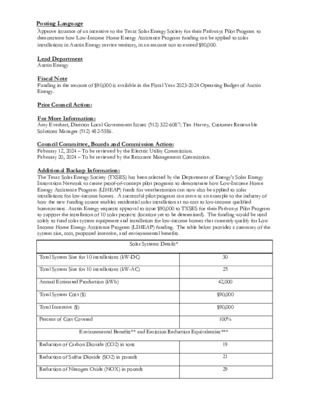Item 4: RCA -Pathways Pilot Program — original pdf
Backup

..Title Posting Language Approve issuance of an incentive to the Texas Solar Energy Society for their Pathways Pilot Program to demonstrate how Low-Income Home Energy Assistance Program funding can be applied to solar installations in Austin Energy service territory, in an amount not to exceed $90,000. ..De Lead Department Austin Energy Prior Council Action: Fiscal Note Funding in the amount of $90,000 is available in the Fiscal Year 2023-2024 Operating Budget of Austin Energy. For More Information: Amy Everhart, Director Local Government Issues (512) 322-6087; Tim Harvey, Customer Renewable Solutions Manager (512) 482-5386. Council Committee, Boards and Commission Action: February 12, 2024 – To be reviewed by the Electric Utility Commission. February 20, 2024 – To be reviewed by the Resource Management Commission. Additional Backup Information: The Texas Solar Energy Society (TXSES) has been selected by the Department of Energy’s Solar Energy Innovation Network to create proof-of-concept pilot programs to demonstrate how Low-Income Home Energy Assistance Program (LIHEAP) funds for weatherization can now also be applied to solar installations for low-income homes. A successful pilot program can serve as an example to the industry of how the new funding source enables residential solar installation at no cost to low-income qualified homeowners. Austin Energy requests approval to issue $90,000 to TXSES for their Pathways Pilot Program to support the installation of 10 solar projects (location yet to be determined). The funding would be used solely to fund solar system equipment and installation for low-income homes that currently qualify for Low Income Home Energy Assistance Program (LIHEAP) funding. The table below provides a summary of the system size, cost, proposed incentive, and environmental benefits. Solar Systems Details* Total System Size for 10 installations (kW-DC) Total System Size for 10 installations (kW-AC) Annual Estimated Production (kWh) Total System Cost ($) Total Incentive ($) Percent of Cost Covered Reduction of Carbon Dioxide (CO2) in tons Reduction of Sulfur Dioxide (SO2) in pounds Reduction of Nitrogen Oxide (NOX) in pounds 30 25 42,000 $90,000 $90,000 100% 19 21 29 Environmental Benefits** and Emission Reduction Equivalencies*** Equivalency of Vehicle Miles Driven Equivalency of Cars on Austin Roadways Equivalency of Trees Planted Equivalency of Forest Acreage Added 44,187 3.8 285 0.114 *All solar equipment meets Austin Energy program requirements ** Environmental Benefits based on the US Energy Information Association’s state-wide electricity profile *** According to the Environmental Protection Agency (EPA)’s Greenhouse Gas Equivalency Calculator An Austin-based organization, TXSES is a 501c3 not-for-profit formed to support an equitable, inclusive approach to deploying distributed solar energy. The Low-Income Home Energy Assistance Program (LIHEAP) is a federal program that assists eligible low- income households with their heating and cooling energy costs, bill payment assistance, energy crisis assistance, weatherization, and energy-related home repairs. The purpose of these solar projects is to demonstrate financial effectiveness that would unlock LIHEAP funds to subsidize solar projects for low-income qualified homeowners moving forward. This funding is to provide a pathway to promote the installations of no-cost, renewable energy to underserved populations and leverage the Value-of-Solar benefit to reduce electric bills for low-income homeowners. According to the updated Austin Energy Resource, Generation and Climate Protection Plan, approved by Austin City Council in March 2020, “Austin Energy will achieve a total of 375 MW of local solar capacity by the end of 2030, of which 200 MW will be customer-sited (when including both in-front-of-meter and behind-the meter installations).” To meet these goals, Austin Energy has funded the Solar Photovoltaic (PV) Programs, which are designed to reduce the amount of electricity Austin Energy must purchase from the market and reduce associated greenhouse gas emissions. The Generation and Climate Protection plan also specifies that Austin Energy is to "Provide moderate and limited-income customers preferential access to community solar programs.” This project will advance the stated goals of expanding locally sited solar, carbon reduction and resiliency, extend the adoption of solar to entities historically excluded from the investment benefits of solar, and continue to demonstrate the value and importance of renewables as part of the individual and collective generation portfolio in Austin Energy territory.